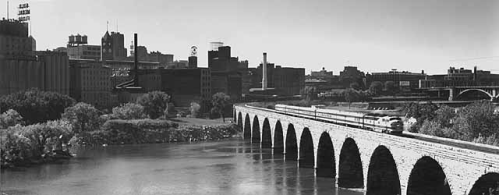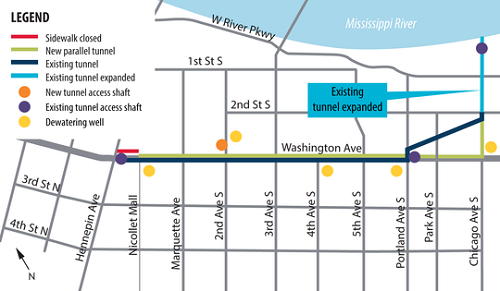Article by Becky Fillinger
 Rich MelzerSix thousand young people are currently experiencing homelessness in Minnesota. There is an organization in Minneapolis that has been serving this vulnerable population for over 45 years – YouthLink. We talked to newly installed CEO, Rich Melzer, about the challenges and dreams for this outstanding local nonprofit.
Rich MelzerSix thousand young people are currently experiencing homelessness in Minnesota. There is an organization in Minneapolis that has been serving this vulnerable population for over 45 years – YouthLink. We talked to newly installed CEO, Rich Melzer, about the challenges and dreams for this outstanding local nonprofit.
Q: YouthLink has been in Minneapolis for over 45 years. Can you give our readers a short history of the organization and the mission?
A: You’re right – YouthLink has been serving tirelessly in this field of ending youth homelessness for almost half a century. During even the most challenging and difficult times for the organization, we continued to deliver at a very high clip and even more so during some of the brighter and more opportunistic phases. In recent years, YouthLink was led by Dr. Heather Huseby, whose work and experience continue to surface and we carry her legacy and life’s work forward.
Ultimately, we continue to serve young people experiencing homelessness and the accompanying challenges they face every day of the week. Whether it is basic needs like food, clothing, toddler support or simply refuge from the streets, we can provide that safe space and nourishment in a clean, visually appealing, and holistic environment every day at our drop-in center. Additionally, and perhaps even more importantly, we set young people up directly with realistic long-term housing opportunities to get them off the streets, into stable housing and have our organization and partners’ resources wrapped around each young person we serve. We’re literally feeding, protecting, nurturing, serving, and housing the most vulnerable youth in the Twin Cities every day. Our mission and work will continue until our goal of ending youth homelessness is met.
 CEO Rich Melzer and clients
CEO Rich Melzer and clients
Q: You’ve been CEO for about four months now. As you’ve settled into your new role, what priorities and opportunities are on your to-do list?
A: The priority or to-do that has blossomed since my arrival is more of a question, “How are we dreaming for young people?” Are our dreams big enough, are they realistic and if they are not realistic, how do we accept the challenge and responsibility to make these larger dreams more so? I would say we’re among another one or two organizations in the Twin Cities recognized as a centralized location for youth homelessness. Is that enough for us as an organization? Particularly one like ours with a high-quality brick and mortar location in the center of the metro, with a downtown view (our youth housing building) connected directly next to our drop-in center and Nicollet Square (another youth housing building supported by YouthLink) just minutes from our home-base? If we are not the “mecca” for youth homelessness in the Twin Cities right now, we certainly will continue to aspire to be because we have the resources, the developing team and the partnerships in place to do so. We also know that to be successful we must tandem these efforts with other like-minded organizations like The Bridge for Youth, Avenues for Youth, Hope Street Shelter, and others like us that dream of ending this phenomenon of youth homelessness.
Q: When your appointment was announced, I heard people comment that your outstanding reputation in the nonprofit and sports world would gather positive attention from the business community and other organizations. Are you forging new relationships, or reenergizing existing relationships, for YouthLink?
A: Advancing existing and new relationships will be a lifelong commitment of mine because I believe that in this work, we’re irrefutably stronger in numbers. With that said, YouthLink has been so committed to this work for so many years that fortunately for me and this team we don’t have to reinvent the wheel entirely either. As it relates to right now, we’re loving our supporters and identifying a who’s who to match their personal passions and heart-string passions with the resources we need most. We know who supports us philanthropically, who advocates for us to the community and who we need to partner with now more than ever. We’re evaluating what is going to lead that larger dream of ours to be impactful around anything involving youth homelessness. We are also building greater capacity and bandwidth around our individual supporter base by tying the mission and the evolving work of YouthLink to the people who care about young people and service most. Simply put, we’re continually connecting and reorganizing the dots (relationships and partners) that bind us to make a difference together.
 YouthLink's Drop-in Center is a safe, non-judgmental place for youth 16-21 years old from all backgrounds, races and genders.
YouthLink's Drop-in Center is a safe, non-judgmental place for youth 16-21 years old from all backgrounds, races and genders.
Q: What is the biggest challenge YouthLink is facing and how are you and your team addressing it?
A: We’ve had three full revolutions of organizational turnover in the three years prior to my arrival. As meaningful as the work we’ve been doing is, it seems we may have missed the calling to really nurture and provide for our staff and service providers. While we obviously have an obligation to the young people experiencing homelessness, we’re pouring a ton of time and energy into our team members to ensure they feel loved, appreciated and supported by YouthLink, as not only an organization but as a place of employment they’re proud to be at and feel supported by. Our goal is to provide our team members and staff with as many resources as possible. We’ve implemented unique performance reviews and processes that probably don’t sound attractive to most but for an organization that hasn’t had a simple application like this, it’s a leap in the right direction. We’ve worked with the YMCA of the North to give our team members greatly reduced memberships so they can decompress, exercise and bring a healthy balance with them to work in hopes of continuing to promote a healthy work environment. We’ve learned that a large percentage of our team members are renting homes and apartments and by having this information we’re proud to partner with long-time supporters of ours at Old National Bank who will educate our staff with first-time homebuyers’ programs, financial literacy and educational tools, down payment assistance programs and more. Our wages at YouthLink are very fair and competitive given our industry and we want the team members to feel empowered by YouthLink to reach the goals and dreams they’ve aspired to as professionals and individuals.
One of the first questions I asked when I got to YouthLink was, “Where does one go for therapy?” and “What other resources are there for the ones on the front lines to really decompress holistically and positively in a healthy way?” Sadly, there’s been very little historically other than what’s likely been available to our young people we serve. This is an area we incorporate into our benefits packages, YMCA memberships and resources through AVIVO, to ultimately say, “We love you…we want you well when you’re at work…we want you to feel supported and cared for.” The end goal of course is to create a culture of people who hope to be here and value being here, while also growing personally and professionally while they’re with us.
Q: Do you have a need for volunteers? How may we as individuals help YouthLink?
A: Volunteerism is at an all-time high, and we love new faces! However, our work requires confidentiality to protect the integrity of our young peoples’ information and private stories. If someone has a real passion for volunteering, contact Carley Kleinhans, our Volunteer Leader at kleinhans@youthlinkmn.org and she and I will get you squared away based on the interests and passions that drive you to give back. If you want to make a charitable donation, please reach out to Heather Haynes, our valued Director of Development at haynes@youthlinkmn.org. With all the challenges the young people we see face, we depend on philanthropy and in-kind monetary gifts. The drug epidemic, the heat, human trafficking, mental health, housing instability, broken homes, sexually exploited youth – we see and support every case we can involving young people experiencing homeless and worse. While we have partners we value immensely and remain endlessly loyal to, we as an organization and service could not offset this phenomenon without dollars and passionate supporters to assist us financially. We have some unique studies to support how we’ve helped and what the cost to love a homeless young person looks like, and we’re proud to report that this particular longitudinal study by the University of Minnesota states that every young person who enters our doors benefits unequivocally and irrefutably after coming to YouthLink.
 Q: How may we follow your news?
Q: How may we follow your news?
A: We have our website and Facebook pages online. We’re also regularly featured on WCCO radio with Mike Max and other industry media outlets quite regularly. Tell your friends about the work we do. If anyone would like, they can contact our Communications Director, Sarah Johnson sjohnson@youthlinkmn.org, to get placed on an email list.
 Wednesday, June 29, 2022 at 2:02PM |
Wednesday, June 29, 2022 at 2:02PM |  Kim Eslinger |
Kim Eslinger | 











































































